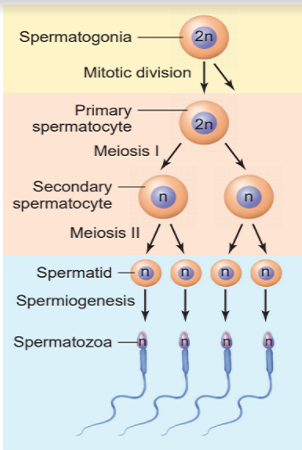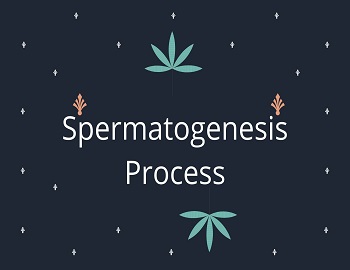Table of Contents
Spermatogenesis Process:
Spermatogenesis is the process where sperm mother cells in seminiferous tubules of testes change into the haploid spermatozoans. It is a continuous process that starts when the male attains puberty and remains in continuity till death. The process of spermatogenesis takes place in two stages-
- Formation of Spermatids.
- Formation of spermatozoa.
Formation of Spermatids:
The formation of spermatids takes place in three stages i.e. multiplication phase, growth phase, maturation phase.
Multiplication Phase:
The undifferentiated germ cells present in the seminiferous tubules of the testes are called the spermatogonia or sperm mother cells. They are proliferated by mitotic divisions from the primary germ cells of the germinal epithelium lining the seminiferous tubules. The spermatogonia have prominent nuclei that contain a 2n or a diploid number of chromosomes, 46 in humans. The spermatogonia increase their population by repeated mitotic divisions so that each newly formed spermatogonium possesses the same number of chromosomes, i.e. 46. The addition of spermatogonia provides for the growth of the testes during the early life of the animal.
Growth Phase:
Some spermatogonia stop division and increase in their size by the accumulation of cytoplasm and nutritive materials. They become change into primary spermatocytes (2n). This process is called spermatocytogenesis. Primary spermatocytes are double the size of spermatogonia. The remaining spermatogonia regularly undergo mitotic division to increase the number of spermatogonia for future spermatogenesis.
Maturation Phase:
The primary spermatocytes are ready for first meiotic or maturation division. The homologous chromosomes start pairing (synapsis), each homologous chromosome splits longitudinally and by the chiasma formation, the exchange of genetic material or crossing over takes place between the chromatids of the homologous chromosomes. The DNA amount is duplicated at the beginning of the division. By first meiotic division or homotypic division, two secondary spermatocytes are formed. Later on, secondary spermatocytes undergo 2nd meiotic division or heterotypic division, which is equational. It results in the formation of four spermatids. All these are haploid.
Formation of spermatozoa or Spermiogenesis:
It is the transformation of an unspecialized spermatid into a spermatozoa (sperm). The spermatids get embedded in the Sertoli cells which provide support, protection and nutrition. The spermatid gets transformed into sperm by losing a great deal of cytoplasm, condensation of the nucleus into a head and by the formation of a flagellated tail. During development, the flagellated tail of the sperm projects into the lumen while the head is embedded in the Sertoli cells. The mature spermatozoan or the sperm finally gets detached and is released in the lumen of the seminiferous tubule by the process called spermiation.

Significance of Spermatogenesis:
- Each primary spermatocyte undergoes two maturation divisions (meiosis I and II) and produces four spermatids with half the number of chromosomes.
- It is necessary to maintain the number of chromosomes constant from generation to generation. Since the somatic cell contains diploid number of chromosomes, and if sperm and ovum each had diploid chromosomes., then their fusion would lead to doubling of chromosomes at each successive generation.
- During meiosis I, crossing over takes place which provides for new combination of genetic material. This brings about variation and thriough them evolution.









Comments (No)